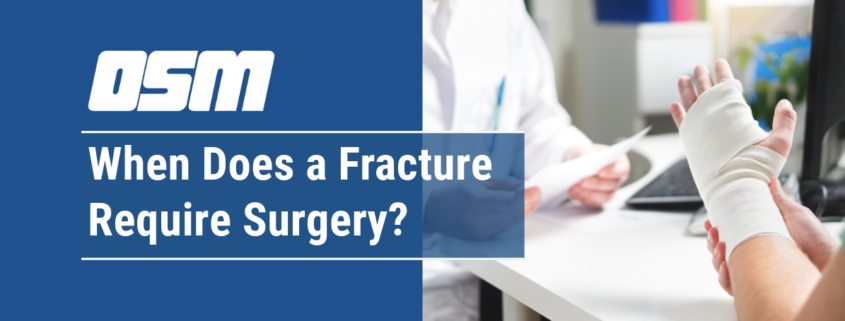When Does a Fracture Require Surgery?
Article featured on BCOS
A bone fracture is a broken bone. Bone fractures are one of the most common injuries orthopaedic doctors see. About 6.8 million people fracture a bone every year, with the most common being hip, ankle and leg bone fractures.
Bones are strong so it takes a big impact to break or fracture one. Bone fractures are most commonly caused by a car accident, a fall, or a sports-related injury. Osteoporosis, a condition where bones become brittle and weak, is related to numerous fractures as well.
While many bone fractures can heal with a cast, others require surgery to treat. The experienced orthopaedic surgeons at Burlington County Orthopaedic Specialists share important information on different types of fractures and when a fracture might require surgery to heal properly.
TYPE OF FRACTURE
Some bone fractures are minor with just a hairline fissure on the bone, while others result in a bone being broken into two or more pieces. The type of fracture will dictate your treatment options.
A hairline or stress fracture is a minor fracture, although one that may be difficult to detect in an x-ray, where there’s a small chink or simple line in the bone. A complete fracture is when the break goes through the bone, breaking it into two pieces. With an open fracture, the bone has broken through the skin, and a comminuted fracture means the fracture has shattered.
BONE FRACTURE SYMPTOMS
If the bone is sticking through your skin, it’s simple to figure out that you’ve broken it. In other cases, it’s no so evident that your injury caused a fracture.
Bone fracture symptoms include:
- Severe pain
- Swelling
- Bruising
- Difficulty using or bearing weight on the limb
In some cases, the limb looks deformed or is sitting at a strange angle.
FRACTURES THAT REQUIRE SURGERY
The goal of fracture treatment is to allow the bone to heal and fuse back together. Often, this can be accomplished by immobilizing the bone for several months with the help of a cast and splint. The more severe the fracture is, the more likely it is that surgery will be recommended.
For example, an open or comminuted fracture will require surgery to ensure that the bone full grows back together and safely supports your weight. Surgical repair entrails using metal rods, screws, or plates to set the bone in place or align it while it heals.
The Orthopedic & Sports Medicine Center of Oregon is an award-winning, board-certified orthopedic group located in downtown Portland Oregon. We utilize both surgical and nonsurgical means to treat musculoskeletal trauma, spine diseases, foot and ankle conditions, sports injuries, degenerative diseases, infections, tumors and congenital disorders.
Our mission is to return our patients back to pain-free mobility and full strength as quickly and painlessly as possible using both surgical and non-surgical orthopedic procedures.
Our expert physicians provide leading-edge, comprehensive care in the diagnosis and treatment of orthopedic conditions, including total joint replacement and sports medicine. We apply the latest state-of-the-art techniques in order to return our patients to their active lifestyle.
If you’re looking for compassionate, expert orthopedic and podiatric surgeons in Portland Oregon, contact OSM today.
Phone:
Address
17355 Lower Boones Ferry Rd Suite 100A
Lake Oswego, OR 97035
Hours
Monday–Friday
8:00am – 4:30pm



